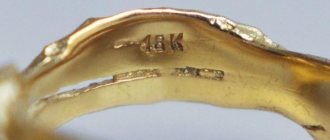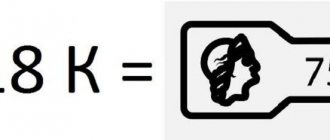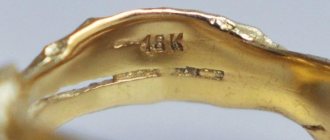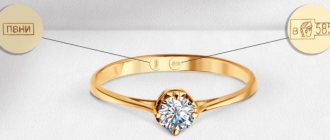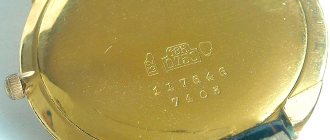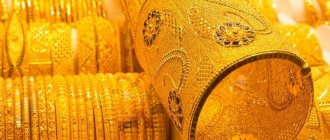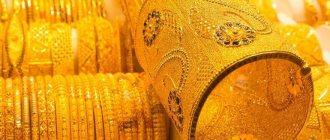Hello, dear readers! Most of us have gold jewelry at home, purchased at different times. They are marked with hallmark 585, and if they have been preserved from Soviet times, then 583. In European countries you can buy products made of yellow metal of various shades, on which it is impossible to find the hallmark we are used to.
How to determine what we have in front of us: precious metal or ordinary jewelry? Many readers are interested in: 14 carat gold – what is the purity and how to easily recalculate the units of measurement so as not to buy a fake. We learn all this from the article.
Gold is a traditionally yellow precious metal. It is impossible to make jewelry from pure metal, as it is fragile and ductile. To increase the strength of products made from precious material, alloys are produced on its basis with additives that increase strength and wear resistance. Auxiliary components are called “ligature”. The fewer additives in the alloy, the more vulnerable the product, and the more easily scratches form on it.
What is carat
The term "karat" is used in jewelry to measure the percentage of pure gold in a piece. It is necessary to distinguish between a gold carat and a diamond carat.
For abbreviated designation, the symbol “k”, “K” or the abbreviation “KR” is used. If for precious stones an increase in carat indicates a larger size and leads to an increase in price exponentially, then carats in gold have standard values: 10, 14, 18, 20, 22, a figure of 24 is rare. All products with a purity of less than 10 carats are technically are not considered gold.
Origin of the word
Initially, in different parts of the world, the reference value for determining weight was equated to the weight of cereals traditional for a given region. The word “carat” came to us from the countries of the Middle East, where jewelry has always been a sign of prosperity and wealth. There, the measure of weight was chosen to be the seed of the acacia, or carob, which had a stable size and sounded like “keration” in Greek.
This system was very approximate, and in different countries the same stone could have different prices. For this reason, in 1877, European merchants decided to consider a carat equal to 205 mg. Years later, for a simpler translation, the value was taken to be 1/5 g.
As for alloys, carat denotes the mass fraction of pure gold in it, measured in 24 parts of the total weight.
Interesting Facts
Over the entire history of mankind, people have been able to extract more than 200 thousand tons of pure gold from the bowels of the earth. If a geometric figure were cast from it, the result would be a cube the size of a high-rise building.
There are other interesting facts about this metal:
- Most of this gold is contained in the earth's core. If it poured onto the earth's surface, the entire Earth would be covered with a half-meter golden layer! The earth's core contains more of it than the entire world.
- This element is even found in water. Each liter contains from 0.02 to 0.04 milligrams of gold.
- The largest statue, made of precious metal, weighs about 250 tons. According to legend, the goddess Semiramis ordered this item to be made. The statue of the goddess Rhea was made of the purest metal - she sat on a throne and was surrounded by luxurious golden lions. This historical monument has not survived to this day, but it is mentioned in books.
- The largest gold reserves are in the United States - about 8 thousand tons. The second position is occupied by Germany, which contains more than 3 thousand tons of this metal. It is followed by other European countries - Italy and France. China, Japan, Switzerland, as well as Russia and the Netherlands are not far behind them. In India, most of the gold belongs not to the state and authorities, but to ordinary citizens.
- Just 30 grams of pure gold can be used to make a thread 80 km long. It will be much thinner than human hair. This feature is explained by the physical properties of the element - gold is a very viscous and malleable substance.
- The metal is very rare. Every day, steel is cast in the world in the amount in which gold has been mined in the entire history of human existence.
- Gold is used not only in jewelry, but also in the food industry. In some Asian countries, it is added to fruits, baked goods, and various drinks. Gold leaf has been used in the alcohol industry for a long time. This element is added to bottles with particularly expensive spirits.
- During the crisis in 2008, the price of one ounce of metal exceeded 1 thousand dollars. This was the only case ever.
- To make a medal for Olympic champions, only 6 grams of gold are used, since only the outer shell is cast from it.
- The Bible mentions this connection more than 400 times! In the main book there are instructions from the Lord about covering furniture with metal. The gold was presented by one of the wise men as a gift for the baby Jesus.
- Jewelry with a purity lower than 375 is considered non-jewelry and is considered the same as regular costume jewelry.
Experts recommend buying gold only in large, reliable stores. You should not chase cheap products, since high-quality precious metal cannot have a low price.
How to determine carat content
To determine the carat value, you need to multiply the number of grams of gold in the product (that is, its fineness) by 24 and divide by 1000. For example, 900 x 24 / 1000 = 21.6. According to the correspondence tables, sample 900 corresponds to a value of 22k, but the American system allows an error of +/- 0.5k. Therefore, the actual carat value may be less than stated.
To buy a product with a guaranteed number of carats, you need to look for the “KR” marking on it.
Allergy to nickel.
Nickel is sometimes used in gold alloys. It is found in high concentrations in low purity alloys. Therefore, people with nickel allergies are more sensitive to 10 or 14 karat jewelry, while 18 or 22 karat nickel-containing jewelry does not cause an allergy.
Nickel-containing 18-, 20-, and 22-karat jewelry has an advantage over 14-karat jewelry made with the same metal: purer alloys contain less of it (as a percentage) and are therefore less likely to cause an allergic reaction if you are susceptible to it.
If you are allergic to nickel, 18K gold products will be preferable to 14K gold. Keep in mind that if you are too sensitive, you may need an even higher carat.
If you are prone to allergies but want to purchase 14K jewelry, look for items that do not contain nickel. Typically, such jewelry is labeled “nickel free.”
Sources
- https://zhazhdazolota.ru/proby/14-karat
- https://golden-inform.ru/proby/zoloto-14-karat-kakaja/
- https://TokyoStreet.ru/dragocennye-kamni/14-karat-zolota-kakaya-proba.html
- https://HochuZoloto.com/proby/zoloto-14k.html
- https://ogems.ru/interesnoe/karat
- https://DragMag.ru/raznica-mezhdu-14-karatnym-i-18-karatnym-zolotom/
- https://vplate.ru/zoloto/14-karat/
- https://zolotoe-runo-sl.ru/proba/1-karat-skolko-gramm.html
- https://1nerudnyi.ru/chto-takoe-karat-01/
- https://jewellerymag.ru/p/carat/
- https://ToZoloto.ru/proba/osobennosti-izdelij-iz-splava-zolota-14-karat.html
- https://VseoMetallah.ru/zoloto/proba/14-18-24-karata
How to convert to the metric system and sample correspondence table
In Russia, the metric system is used, which clearly demonstrates the amount of pure metal in grams per kilogram of alloy. The karat system means that 100% pure gold has 24 carats. Banking bars are made from pure 999 purity material, and products made from it are very soft and easily damaged. An ingot with minor scratches immediately loses part of its value.
Expert opinion
Vsevolod Kozlovsky
6 years in jewelry making. Knows everything about samples and can identify a fake in 12 seconds
To convert carats to the metric system, you need to multiply the carat marking by 1000 and divide by 24. For example, 18K x 1000 / 24 = 750. It turns out that 18 carats corresponds to the 750th standard.
Using the following sample correspondence table, you can easily convert all existing gold samples from carats to the metric system:
| Metric | Carat |
| 999 | 24 |
| 958 | 23 |
| 900 | 22 |
| 750 | 18 |
| 583 | 14 |
| 585 | 14 |
| 500 | 12 |
| 375 | 9 |
Measurement systems of different countries
Until the beginning of the 20th century, there was no unified system for measuring the weight of precious stones. Each “point of sale” of expensive minerals around the world used its own measure. Because of this, confusion arose when trying to determine the value of the gem, because the difference in weight sometimes reached 0.026 grams, which is quite significant. In Russia, since 1922, it has been generally accepted that 1 carat is 200 mg or 0.2 g.
Metric carat
In 1907, in Paris, the IV General Conference on Weights and Measures adopted the official weight measure for precious minerals and pearls - the carat, which was equivalent to 0.2 grams or 200 mg. The metric carat quickly became the standard jewelry measure for most countries.
English carat
In England, the local measure for the weight of gems was 205.4 mg. The entire weight system of the country, including jewelry, was based on the troy pound, the main English unit. This unit in turn was divided into several others, ultimately resulting in a troy grain equal to 64.79 mg. A carat was equal to 3.17 troy grains until 1888. Afterwards, the Ministry of Commerce determined the weight of the English measure as 205.3 mg. Since 1914, England has used the world metric system.
Arabic carat
The canonical karat or qirat was used throughout Iraq. There, the jewelry unit of measurement was equal to 1/14 of the weight of the local silver coin - the dirham, which is proportional to 223.2 mg. The Kirat of Syria, Egypt and Mecca differed significantly in weight, answering 195 mg. At the same time, the Egyptian qirat was put in relation to its own measures of weight - bakila and shamuna. The Kyrat of Asia Minor was also different, equaling 204 mg.
Alternative weights
In addition to the generally accepted carat weight system, jewelers use the following terms:
- Jewelry gran is a unit equal to ¼ carat or 50 mg. Today it is no longer used. Previously, the weight of pearls was determined using grains.
- Gram is a unit used in purchase and sale transactions of raw materials. In jewelry making, it is important to know how many grams are contained in one carat in order to estimate the approximate weight of the stone that can be obtained from this raw material.
- Momme is a measure of weight that is used only by the Japanese to measure the mass of pearls. Momme is 18.75 carats.
The carat of a stone is one of the main criteria for assessing the value of a precious mineral. Therefore, to set the price of a gem, measurements are carried out with maximum accuracy. In abbreviated form, the carat value of a stone is denoted “ct”.
Legislative regulation
At the state level, there is strict control over enterprises working with precious metals. All released products must have a special mark confirming its quality. Even if the deviations in the declared amount of gold are insignificant, entire batches of finished products are sent for processing.
In Russia, the quality control function is performed by the Assay Office. The stamp on products made in the Russian Federation contains a three-digit designation of the sample and a female silhouette. Often the manufacturer's mark is also applied nearby.
About this sample
14K gold contains 58.5% gold and 41.5% ligature. It is thanks to additives that it becomes suitable for further processing.
Composition and properties
Depending on the metals in the alloy, gold changes not only its color, but also its properties. Copper and silver are used as alloys, in different proportions, as well as nickel, zinc, palladium, platinum, and very rarely iridium and ruthenium. Ligature metals affect the properties of gold as follows:
- Red products are durable and do not corrode. This is the most popular color.
- Silver adds ductility, makes the alloy more malleable for forging, and changes color. The more silver in the composition, the easier the processing.
- The white color is obtained due to the presence of zinc, which reduces the melting point of the metal.
- Nickel imparts magnetic properties, the alloy becomes harder and more ductile.
- Copper adds strength but reduces corrosion resistance.
- The alloy with platinum in the composition becomes more elastic, the melting point decreases.
- White gold has the lowest density, which means its mass differs to a lesser extent.
Strength
The softness of gold is the main reason it is used in alloys. The higher the carat value, the less weight and strength the alloy has. 14-karat products contain hard metals, which positively affect its strength, and therefore durability.
Alloy shade chart
| Color | Gold | Silver | Copper | Nickel | Zinc |
| Yellow | 585 | 187 | 228 | — | — |
| Red | 585 | 82 | 333 | — | — |
| Pink | 585 | 182 | 233 | — | — |
| Green | 585 | 359 | 56 | — | — |
| White | 585 | — | 160 | 170 | 85 |
The classic option is reddish gold, which contains 8.2% silver and 33.3% copper. This material does not bend, various products are well made from it, it was from this metal that the famous chervonets were cast.
Currently, white alloys are popular. They are used to frame diamonds and are not subject to contamination.
Brand
The manufacturer does not have the right to apply a mark on his own - this is the prerogative of the Assay Office. On domestically produced 14-karat gold, the hallmark contains 4 elements:
- a letter indicating the department that carried out the inspection (“M” - Moscow, “N” - Nizhny Novgorod, etc.);
- female profile in kokoshnik;
- directly sample 585;
- rectangular frame.
In the West, the marking looks different, and it is applied to both gold and gold-plated jewelry. The stamp contains only the characters “14k”.
When should you buy 18-karat gold?
18K is a good choice if you want jewelry that is fairly clean but not too soft. This alloy, along with 14K gold, is a good compromise between durability and purity.
Of course, 14k gold is harder and more durable.
However, if you are very sensitive to nickel, such items may cause a rash, whereas 18k gold is much less likely to cause an allergic reaction.
It's not a good idea to choose 18K gold for jewelry that you'll wear every day, especially rings and bracelets, which are more likely to get knocked or scratched.
In such cases, 14 or 10 karat gold may be a better option as it is more difficult to bend, break or scratch.
Choose 18K gold for jewelry that you won't wear every day or for jewelry such as necklaces and earrings that are less susceptible to accidental bumps and knocks.
How much does 1 gram of gold of this standard cost?
Gold has long become a hard currency; it is used to carry out payment transactions and evaluate the official reserve assets of states (gold and foreign exchange reserves). To calculate the bank value, you need to multiply 0.585 by the figure established by the Central Bank, but the price in stores and pawn shops may differ significantly.
| Price 999 standard according to the Central Bank | Market value of the sample today | Scrap price | Price in jewelry |
Reasons for the popularity of 14k products
Products made from 14-karat gold are the most popular, since the ratio of metals in the alloy makes it possible to obtain high-quality and durable jewelry at an affordable price. Finished products retain their attractive appearance for many years, do not fade, and can have different shades depending on the ligature.
In addition, many believe that buying jewelry is a profitable investment, since the price of gold does not fall, but constantly tends to rise. In reality, everything is much more complicated and buying jewelry for investment purposes is a stupid idea.
Buying 14K Gold: When Is It a Good Choice?
14 carat jewelry is quite affordable compared to 18 or 22 carat jewelry, which is what makes it so popular among buyers. They are also relatively stronger than cleaner, more expensive products.
If money is no object and you don't intend to wear your gold jewelry every day, you can safely buy jewelry that has high purity.
However, if you are looking for something more affordable and are concerned about durability, consider 14K jewelry.
Choose this type of jewelry if you plan to wear it frequently, especially if it is a ring or bracelet, an item that has a higher risk of damage when worn.
Also, if you have a nickel allergy and the jewelry you buy does not contain nickel, don't go below 14K (if you're really sensitive, you may have to buy an even higher purity).
How to avoid becoming a victim of a scammer
When purchasing gold products abroad, it is important to look specifically at the carat marking. If you come across jewelry with karat markings for sale in Russia, then it most likely entered the country and is sold illegally. When buying such jewelry, you need to be prepared for the fact that imported gold may not reach 585 fineness.
Officially imported precious metals must undergo examination by the Assay Office, after which a standard hallmark is placed next to the original mark, protecting the buyer from deception.
To avoid becoming a victim of fraudsters, you need to carefully check the presence of a stamp and sample. It is better to choose products from trustworthy manufacturers.
How to distinguish gold from gilding
Now let's figure out how to find out whether the gold in front of them is real or not. The easiest way is to check the markings; they are usually applied:
- on the inside of the ring;
- in chains - on rings connecting the clasp to the main part;
- on earrings - on a pin that fits directly into the hole in the ear.
Previously, all stamps were applied by hand, and it was impossible to fake them. Currently, samples are applied using special equipment, and fraudsters have learned to falsify them.
The following facts should alert you:
- the recess of the stamp is clogged with dirt;
- it is impossible to read the sample number or carat marking even through a magnifying glass;
- numbers are unclear or crooked.
There is a lot of advice on the Internet about testing the authenticity of gold by applying nitric acid or aqua regia. But, firstly, it is not easy to find these reagents, and secondly, you risk ruining the decoration. Therefore, it is better to contact an experienced jeweler with this question.
There are also funny and useless ways to check, such as biting the product and checking with a magnet. These methods are unreliable and can be used by scammers.
Expert opinion
Vsevolod Kozlovsky
6 years in jewelry making. Knows everything about samples and can identify a fake in 12 seconds
A product made of real gold should be smooth, durable, and not leave dents or scratches. Gold-plated silver jewelry has a standard of 800, 830, 875, 925, 960.
Over time, the gilding wears off or darkens.
Imported gold plated jewelry is marked with the abbreviation “KGP”. Gilding in English - Gold Platted (a thin layer that will quickly be erased) or Gold Filled (a thicker layer). It is important that the marking contains only the symbols “14k” and no other designations either before or after them.
Determination of authenticity
The desire to purchase jewelry at a low price most often ends in great disappointment, since gold cannot be too cheap.
The sample of the State Assay Office is considered a guarantor of authenticity and quality, but some craftsmen have learned to counterfeit jewelry, which entails criminal liability.
When purchasing 14k gold jewelry, a person runs the risk of being deceived. Such products are sold in exotic countries in huge quantities at a price that is significantly lower than Russian jewelry.
They are easy to forge - you can put an imprint with such a carat designation on almost any metal. Unscrupulous sellers do this, and apply gold plating on top. When the deception is revealed, it will be difficult for the tourist to prove anything, so it is better to give preference to domestic products.
At home
The main method for determining the quality of gold is its careful visual inspection. Prints must be clearly visible and even. When examined with a magnifying glass, an image of a woman in a kokoshnik or a star should be visible.
The most common fakes are products made of beryllium bronze (its other name is randol). They bear a mark dating back to Soviet times, which is difficult to distinguish from the present. Randol is almost impossible to distinguish from the original. However, such fakes are found only in simple jewelry, since it is impossible to make complex jewelry from randoli. There are two types of products - men's signets and classic wedding rings.
Copper alloys can be quickly determined at home. They have two distinctive features :
- Clunk. A real precious ring will ring loudly when thrown onto a flat, hard surface.
- Hardness. Gold jewelry has many microscopic scratches and various abrasions on the surface. This can be noticed upon detailed examination of the item. Brass or copper items have a solid shape, they have no selection.
When purchasing woven bracelets and chains, you must definitely pay attention to the connecting ring between the lock and the chain - it must be sealed. All links in the chain must be solid.
You need to carefully examine the joints - there should be abrasions on them, but there cannot be stains of other shades on the original. If the metal in this part is slightly different in color, then this is a clear sign of a fake. When choosing jewelry set with stones, you need to carefully examine the setting. If the inserts are crooked, then the buyer is looking at a fake. In original jewelry, the setting is of high quality, since this operation requires the work of a highly qualified specialist.
Often sellers want to pass off gold plating as a precious metal. In the jewelry industry, gold plating is applied to silver items and their hallmarks are different from the gold standard - 925, 830 or 875. These are silver standards that are not the same as hallmarks on gold jewelry. The prints differ not only in meaning, but also in size and shape. If there is no sample, you can rub the ring with a nail file. The spraying will come off easily after such manipulations.
Chemical methods
With the help of available tools, you can simply determine the quality of jewelry.
There are several ways:
- With the help of iodine. If you apply it to a gold ring, it will leave a brown mark. For the reaction to occur, the jewelry must be left in contact with the iodine for several minutes. Copper alloys do not react in any way to iodine.
- Nitric acid. This method is suitable for mass verification of jewelry authenticity. This method is the most reliable. You need to apply a drop of nitric acid to the precious item. This can be done using a quartz stick. An item with a 585 stamp will give a reaction within a few minutes, but it will be very weak, and after it a brownish mark will remain on the surface. A violent reaction will immediately occur on a fake, but the mark will be almost invisible.
- Lapis pencil. It can be bought at any pharmacy. You need to wet the product and run a lapis pencil over it. There will be a mark on the gold.
- Magnet. Using a regular magnet it is impossible to reliably determine a fake, but this method can be used as an additional one. Gold will not react to a magnet, but steel jewelry that imitates a platinum product will be attracted to it.
Care Tips
In order for gold jewelry to please the eye for as long as possible, you need to take care of it. You should not bathe in jewelry, wash dishes, sleep, or apply cream or cosmetics. It is better to store each accessory in separate packaging to minimize friction. Experts advise:
- Wash your jewelry regularly with warm water and detergent dissolved in it;
- do not use abrasives;
- use professional cleaning services.
These simple rules will help keep your jewelry in its original form for a long time.
